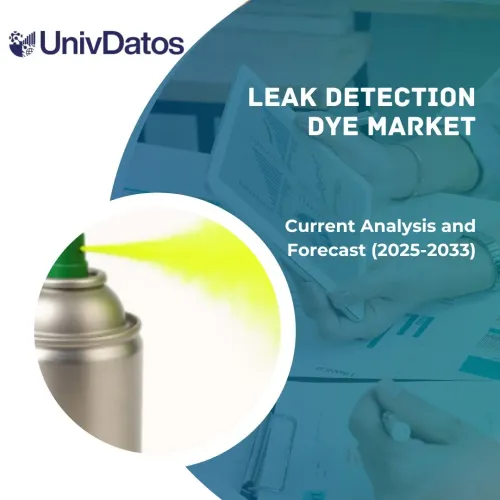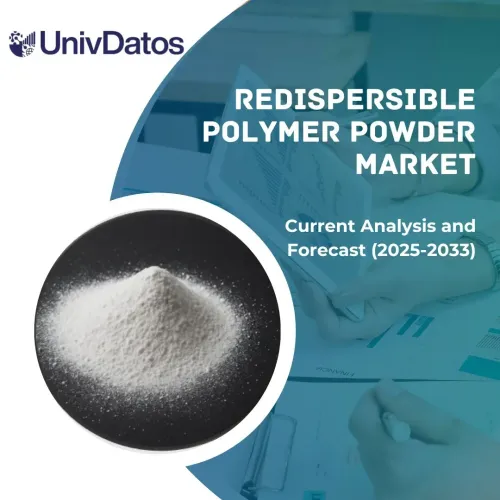- Home
- About Us
- Industry
- Services
- Reading
- Contact Us
Camouflage Coatings Market: Current Analysis and Forecast (2025-2033)
Emphasis on Type (Liquid Coating, Spray Coating, and Powder Coatings); Application (Textile Coatings, Paints and Finishes, and Others); End Use Industry (Defense, Construction & Infrastructure, Marine, Aerospace, and Others); and Region/Country
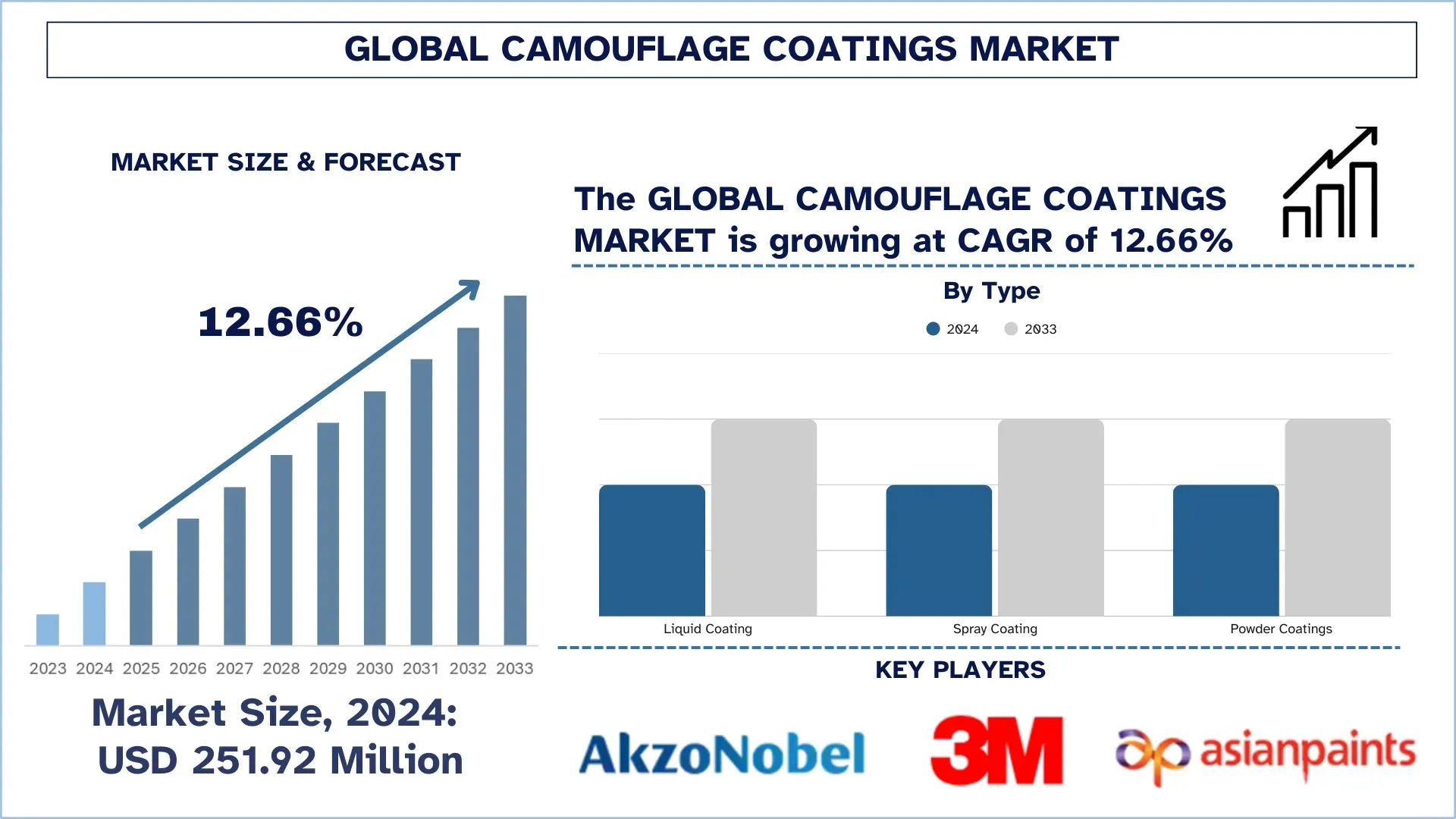
Global Camouflage Coatings Market Size & Forecast
The Global Camouflage Coatings Market was valued at USD 251.92 million in 2024 and is expected to grow at a CAGR of around 12.66% during the forecast period (2025-2033F), driven by increasing defense modernization programs, growing demand for advanced concealment solutions, and expanding applications across the aerospace, automotive, and homeland security sectors.
Camouflage Coatings Market Analysis
The camouflage coating market worldwide has been growing tremendously due to an increase in demand in the military and defense, aerospace, and industrial sectors. The coating has specially tailored visibility, infrared signature reduction, and a wide range of protection, such as military vehicles, aircraft, and naval ships, and infrastructure that is vulnerable to attacks. Unlike conventional paints, camouflage coatings offer high-performance functions, including thermal management, radar evasion, and adaptability to combined environmental factors, which are crucial for fabrication in stealth missions. The market is expanding due to the continuous use of these coatings by defense agencies and other entities within the industry sector as part of enhancing their operational efficiencies, extending the lifespan of their assets, and meeting environmental and defense requirements to a greater degree. This is putting increased pressure on sophisticated camouflage as the necessity to provide full protection and concealment of military activities, combined with the production of new materials such as those utilizing nanotechnology and infrared reflection evidence, makes it necessary. Furthermore, there is a general expansion of the market in the automotive and renewable energy sectors as people switch to camouflage covers and formulate adaptive and smart paints, adding to the market. These applications will expand as these coatings continue to improve, thereby producing industries based on stealth and protection technologies.
Global Camouflage Coatings Market Trends
This section discusses the key market trends that are influencing the various segments of the global camouflage coatings market, as found by our team of research experts.
Smart and Adaptive Camouflage Technologies
Smart and adaptive camouflage technologies are quickly gaining popularity in the camouflage coatings market globally. These new finishes are capable of varying according to their environmental attributes, including light, temperature, overall landscape, etc., which makes them the best answer in dynamic and changing warfare. As an example, the U.S. Army has been trying to devise reversible camouflage cloths that change color in conjunction with infrared reflectivity to blend in with different habitats, thereby achieving better camouflage in all environments. Adaptive camouflage, similar systems are now being incorporated into contemporary fighter jets and armored personnel vehicles, allowing them to modify their shape as the battlefield changes. These breakthroughs present immense benefits compared to conventional coatings, as they enhance their stealth features and flexibility. Any smart camouflage is an emerging trend in the market.
Camouflage Coatings Industry Segmentation
This section provides an analysis of the key trends in each segment of the global camouflage coatings market report, along with forecasts at the global, regional, and country levels for 2025-2033.
The Liquid Coatings Segment Dominates the Camouflage Coatings Market
Based on type, the camouflage coatings market is segmented into liquid coatings, spray coatings, and powder coatings. In 2024, the liquid coatings segment dominated the market and is expected to continue its leadership throughout the forecast period. This is mainly attributed to the flexibility and excellent performance of liquid coating in a wide range of applications, notably in the defense and aerospace industries. The reason for the preferred use of liquid camouflage coatings on complex surfaces, including the use on military vehicles, military aircraft, and military vessels, is the uniform and durable finish the coating forms that is essential to effective uniform marine concealment and protection. Another important factor in promoting the dominance of the liquid coating is its adhesiveness to the type of coating. They can be developed with a plurality of features such as infrared (IR) and ultraviolet (UV) reflectivity, rendering them suitable for present-day stealth technology. This flexibility to fit in particular applications requirements, like temperature immunity, wear and tear longevity, together with increased protection against external factors, renders the liquid coating a suitable treatment in both military and aerospace uses. In addition, the increasing interest in long and high-performance camouflage, as well as the development of high-level pigments and chemical compositions, all contribute to the influence of adopting liquid camouflage and solidifying it in the market domain.
The Paints and Finishes Category held the Largest Market Share in the Camouflage Coatings Market
Based on application, the camouflage coatings market is segmented into textile coatings, paints and finishes, and others. In 2024, the paints and finishes segment holds the largest market share and is projected to remain dominant throughout the forecast period. The finishes are designed to cover a wide range of objects or resources, including vehicles, aircraft, and equipment, not only to camouflage but also to provide some resistance to poor environmental conditions, such as UV radiation, moisture, and chemicals. The success of paints and finishes lies in their extreme adaptability, which allows for installation on complex fittings and massive surfaces, frequently found in military equipment. There is also more customization available with paints and finishes, where the coating can be designed to meet a particular operational feature, such as infrared reflectiveness and imitation of extreme weather conditions. The growing demand for stealth technologies in the aerospace and defense sectors is also driving the upward movement of the segment, as there remains a need to decrease visibility and implement protection as a primary goal. With the increased use of camouflage coatings, the segment of paints and finishes is on a steady and more assured path forward, with solutions discovered in various fields being critical in areas such as vehicle usage and related paint finishes.
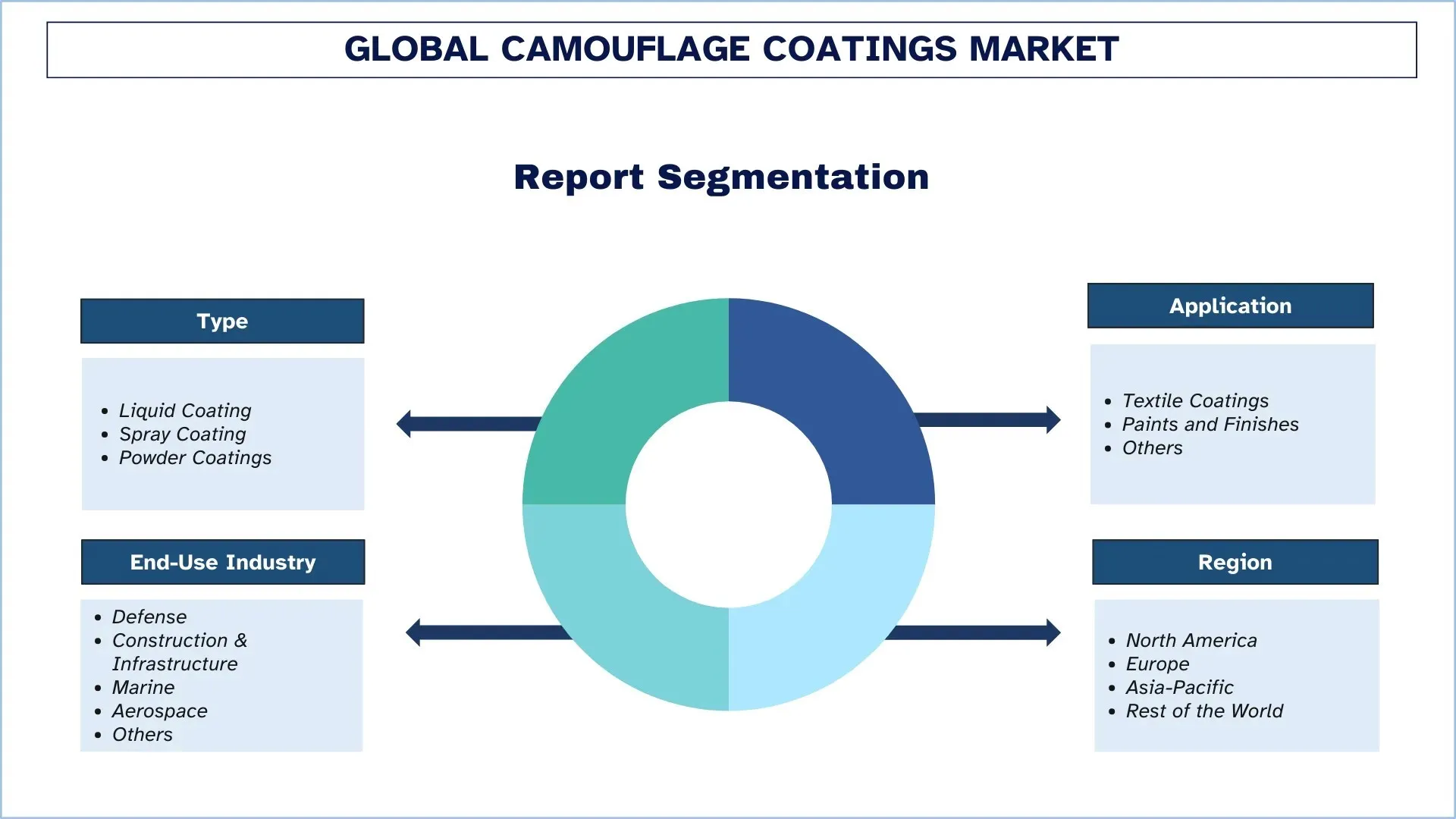
North America Dominated the Global Camouflage Coatings Market
North America is the largest market for camouflage coatings and is expected to maintain its lead during the forecast period. This is due to the heavy expenditure on defense in the area, especially in the United States, which leads in terms of military innovation and modernization. The U.S. military expenditure on next-generation stealth technology, enhanced aircraft, vehicles, and naval vessels, as well as camouflage cover, has significantly staked a claim in the development of the market. Furthermore, North America hosts several of the leading producers of camouflage paint and specialized service providers that offer customized recipes for defense, aerospace, and broader sectors. Its robust defense and aerospace industries, coupled with its focus on infrared and radar-absorbing coatings, also make it a major market for camouflage coatings. This demand is complemented by the stringent environmental laws that specify the use of environmentally friendly and high-performance coatings. Besides, continuous technological progress of adaptive coating systems and intelligent camouflage is driving the boundaries of innovation. North America will remain the key player in the global camouflage coating market, driven by the need to develop superior protection and concealment capabilities.
U.S. held a dominant Share of the North America Camouflage Coatings Market in 2024
The US Camouflage Coatings Market exhibits strong potential and growth prospects, driven by rising military expenditure, modernization initiatives, and the increasing demand for high-tech concealment systems. As the United States continues to have one of the largest military budgets in the world, there is a growing market in next-generation camouflage systems for military vehicles, aircraft, naval equipment, and individual equipment. The use of advanced materials and nanotechnology to provide the capability of delivering multispectral protection, such as infrared and radar signature reduction, is also benefiting the market. Additionally, the trend towards environmentally friendly and sustainable coatings is driving innovations in products, as manufacturers focus on sustainable formulations that meet high regulatory requirements. In addition to defense, expanding markets in homeland security, aerospace, and law enforcement are expanding market usage.
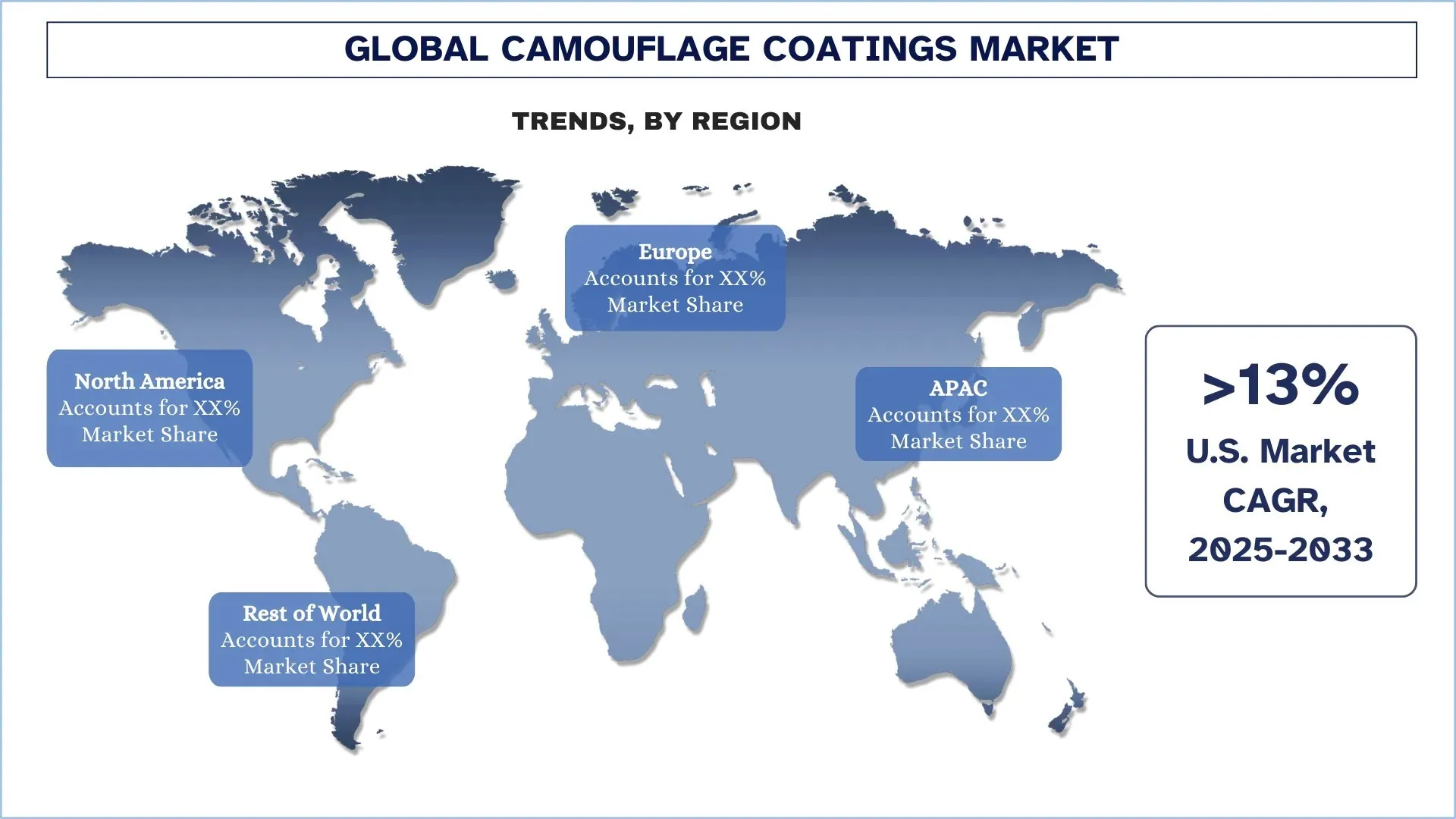
Camouflage Coatings Industry Overview
The global Camouflage Coatings market is competitive, with several global and international market players. The key players are adopting different growth strategies to enhance their market presence, such as partnerships, agreements, collaborations, new product launches, geographical expansions, and mergers and acquisitions.
Top Camouflage Coatings Companies
Some of the major players in the market are AkzoNobel, 3M, Asian Paints, Axalta Coating Systems, BASF Corporation, Berger Paints India, Hempel A/S, DCL Corporation, Huntsman Corporation, and PPG Industries, Inc.
Recent Developments in the Camouflage Coatings Market
In February 2025, AkzoNobel launched its new wood coating, which contains 20% bio-based ingredients as a sign of its commitment to sustainable and eco-friendly innovation. The product combines the reduction of the environmental impact with the pre-existing high-performance levels.
In November 2024, the Indian Institute of Technology (IIT) Kanpur introduced Analakshya, a meta-material surface cloaking system (MSCS). This textile-based material acts as a broadband microwave absorber to improve stealth capabilities against Synthetic Aperture Radar (SAR) imaging.
Global Camouflage Coatings Market Report Coverage
Report Attribute | Details |
Base year | 2024 |
Forecast period | 2025-2033 |
Growth momentum | Accelerate at a CAGR of 12.66% |
Market size 2024 | USD 251.92 Million |
Regional analysis | North America, Europe, APAC, Rest of the World |
Major contributing region | North America is expected to dominate the market during the forecast period. |
Key countries covered | U.S., Canada, Germany, U.K., Spain, Italy, France, China, Japan, and India |
Companies profiled | AkzoNobel, 3M, Asian Paints, Axalta Coating Systems, BASF Corporation, Berger Paints India, Hempel A/S, DCL Corporation, Huntsman Corporation, and PPG Industries, Inc. |
Report Scope | Market Trends, Drivers, and Restraints; Revenue Estimation and Forecast; Segmentation Analysis; Demand and Supply Side Analysis; Competitive Landscape; Company Profiling |
Segments Covered | By Type; By Application; By End-Use Industry; By Region/Country |
Reasons to Buy the Camouflage Coatings Market Report:
The study includes market sizing and forecasting analysis confirmed by authenticated key industry experts.
The report briefly reviews overall industry performance at a glance.
The report covers an in-depth analysis of prominent industry peers, primarily focusing on key business financials, type portfolios, expansion strategies, and recent developments.
Detailed examination of drivers, restraints, key trends, and opportunities prevailing in the industry.
The study comprehensively covers the market across different segments.
Deep dive regional-level analysis of the industry.
Customization Options:
The global Camouflage Coatings market can further be customized as per the requirements or any other market segment. Besides this, UnivDatos understands that you may have your own business needs; hence, feel free to contact us to get a report that completely suits your requirements.
Table of Content
Research Methodology for the Global Camouflage Coatings Market Analysis (2023-2033)
We analyzed the historical market, estimated the current market, and forecasted the future market of the global camouflage coatings market to assess its application in major regions worldwide. We conducted exhaustive secondary research to gather historical market data and estimate the current market size. To validate these insights, we carefully reviewed numerous findings and assumptions. Additionally, we conducted in-depth primary interviews with industry experts across the camouflage coatings value chain. After validating market figures through these interviews, we used both top-down and bottom-up approaches to forecast the overall market size. We then employed market breakdown and data triangulation methods to estimate and analyze the market size of industry segments and sub-segments.
Market Engineering
We employed the data triangulation technique to finalize the overall market estimation and derive precise statistical numbers for each segment and sub-segment of the global camouflage coatings market. We split the data into several segments and sub-segments by analyzing various parameters and trends, including type, application, end-use industry, and regions within the global camouflage coatings market.
The Main Objective of the Global Camouflage Coatings Market Study
The study identifies current and future trends in the global camouflage coatings market, providing strategic insights for investors. It highlights regional market attractiveness, enabling industry participants to tap into untapped markets and gain a first-mover advantage. Other quantitative goals of the studies include:
Market Size Analysis: Assess the current market size and forecast the market size of the global camouflage coatings market and its segments in terms of value (USD).
Camouflage Coatings Market Segmentation: Segments in the study include areas of type, application, end-use industry, and regions.
Regulatory Framework & Value Chain Analysis: Examine the regulatory framework, value chain, customer behavior, and competitive landscape of the camouflage coatings industry.
Regional Analysis: Conduct a detailed regional analysis for key areas such as Asia Pacific, Europe, North America, and the Rest of the World.
Company Profiles & Growth Strategies: Company profiles of the camouflage coatings market and the growth strategies adopted by the market players to sustain the fast-growing market.
Frequently Asked Questions FAQs
Q1: What is the global Camouflage Coatings Market's current market size and its growth potential?
The global camouflage coatings Market was valued at USD 251.92 million in 2024 and is expected to grow at a CAGR of 12.66% during the forecast period (2025-2033).
Q2: Which segment has the largest share of the global Camouflage Coatings Market by Type?
The liquid coatings segment dominated the market and is expected to continue its leadership throughout the forecast period. This is mainly attributed to the flexibility and excellent performance of liquid coating in a wide range of applications, notably in the defense and aerospace industries.
Q3: What are the driving factors for the growth of the global Camouflage Coatings Market?
• Increasing Defense Budgets: Rising defense allocations worldwide are enabling governments to invest in modern camouflage solutions, supporting advanced concealment technologies for vehicles, aircraft, and personnel to strengthen combat readiness and operational effectiveness.
• Technological Advancements in Stealth Capabilities: Innovations such as multispectral coatings, infrared suppression, and adaptive camouflage patterns are enhancing stealth capabilities, reducing detection risks across land, air, and sea domains, and driving wider adoption in defense and security sectors.
• Rising Demand for Enhanced Protection: Growing threats in modern warfare and border security are fueling demand for coatings that offer superior durability, environmental resistance, and multi-terrain adaptability, ensuring effective concealment and long-term protection for military assets.
Q4: What are the emerging technologies and trends in the global Camouflage Coatings Market?
• Smart and Adaptive Camouflage Technologies: The market is witnessing growing interest in coatings that can adapt to changing environments in real time, offering dynamic concealment and improved stealth across multiple terrains and combat conditions.
• Integration of Nanotechnology: Nanotechnology-based camouflage coatings are emerging as a key trend, enabling enhanced durability, lightweight properties, and multispectral protection, while significantly improving resistance against weather, wear, and detection systems.
• Shift Towards Eco-Friendly Solutions: With stricter environmental regulations, manufacturers are focusing on sustainable, low-VOC, and biodegradable camouflage coatings that balance high performance with reduced ecological impact, aligning with global defense sustainability goals.
Q5: What are the key challenges in the global Camouflage Coatings Market?
• High Cost of Advanced Coatings: The development and deployment of advanced camouflage coatings require significant investment, making them expensive and limiting accessibility, particularly for smaller defense contractors and countries with constrained budgets.
• Regulatory Compliance: Strict environmental and defense-related regulations create challenges for manufacturers, as coatings must meet sustainability standards while maintaining high performance, increasing complexity and compliance costs in product development.
• Limited Market Awareness: In many regions, a limited understanding of advanced camouflage technologies restricts adoption, as end-users may prioritize conventional solutions over innovative coatings, slowing market penetration and broader commercialization opportunities.
Q6: Which region dominates the global Camouflage Coatings Market?
North America leads the camouflage coatings market and is set to maintain dominance, driven by high defense spending, modernization programs, and strong adoption of adaptive, eco-friendly, and nanotechnology-based solutions across defense and security sectors.
Q7: Who are the key players in the global Camouflage Coatings Market?
Some of the key Camouflage Coatings company include:
• AkzoNobel
• 3M
• Asian Paints
• Axalta Coating Systems
• BASF Corporation
• Berger Paints India
• Hempel A/S
• DCL Corporation
• Huntsman Corporation
• PPG Industries, Inc.
Q8: What is the current regulatory landscape for the Camouflage Coatings market, and how does it impact manufacturers?
• Environmental Compliance: Regulations mandate low-VOC and eco-friendly formulations, influencing raw material selection and production processes.
• Defense Standards: Military specifications require coatings to meet strict performance criteria like infrared suppression and multispectral protection.
• Export Controls: International trade policies and defense export regulations restrict supply chains, affecting global market expansion.
Q9: How do technological advancements shape investment opportunities in the Camouflage Coatings market?
• Adaptive Camouflage: Demand for smart, environment-responsive coatings attracts R&D funding and partnerships.
• Nanotechnology Integration: Enhances durability, stealth, and multispectral protection, drawing interest from defense contractors.
• Digital Customization: The Growing trend of pattern personalization increases adoption across military and homeland security.
Related Reports
Customers who bought this item also bought



